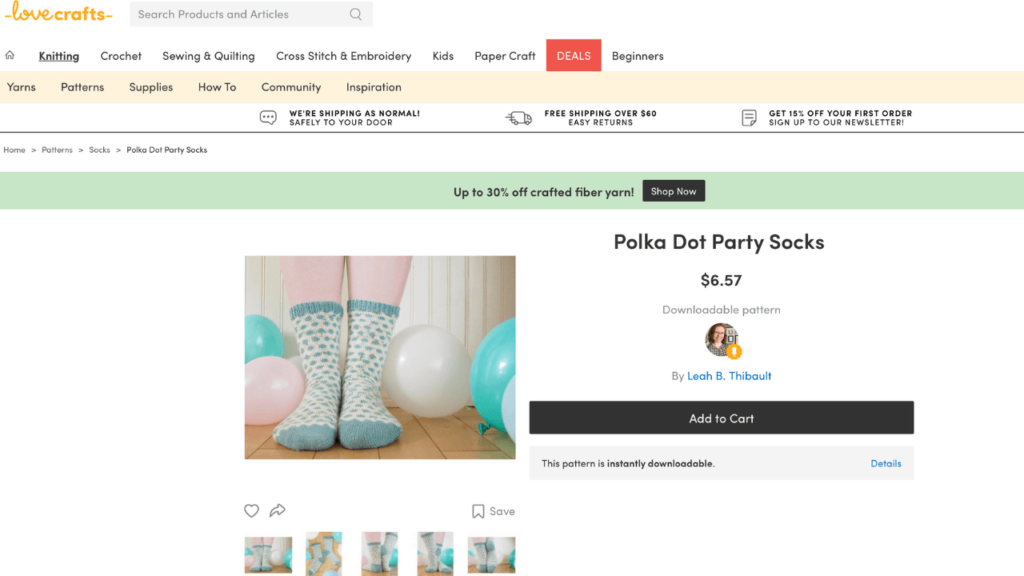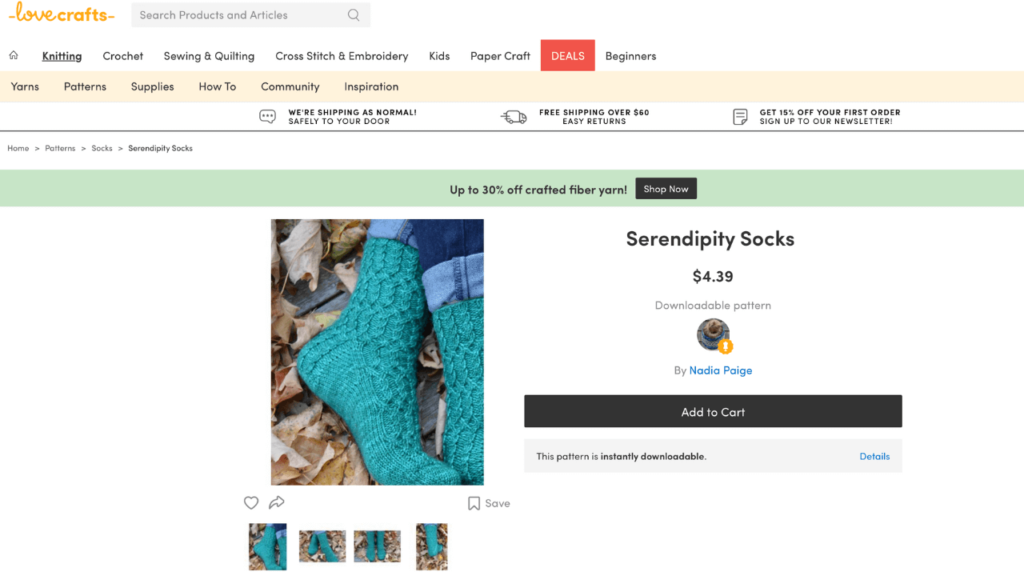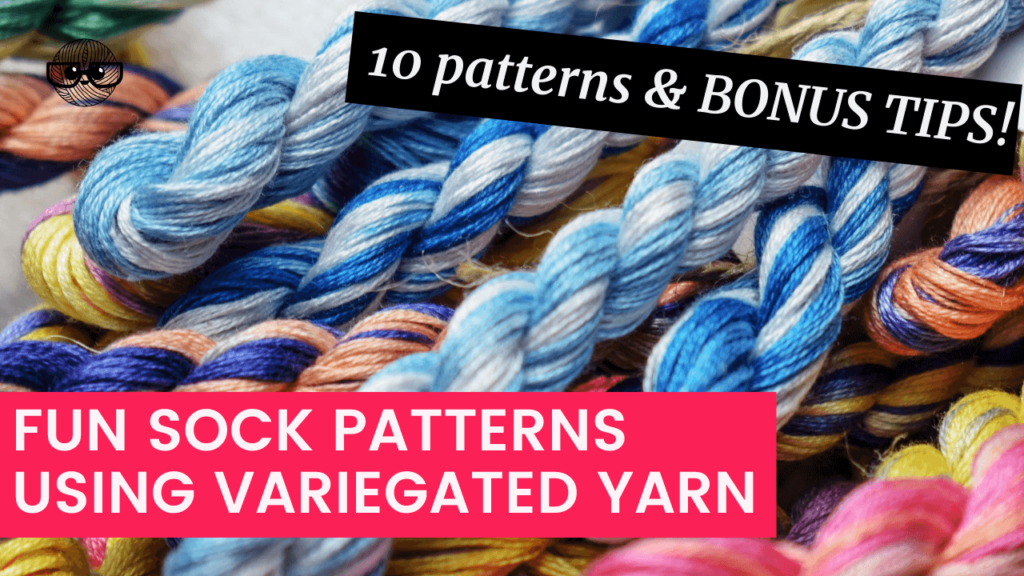Hand-dyed variegated sock yarn is a common purchase for many knitters – all those colors are so fun! But once it’s home sitting on your shelf, coming up with a project idea for that yarn can feel a bit daunting. I’ve collected my favorite sock patterns for variegated yarn – that are perfect for using that single skein splurge!
Here are 10 fun sock patterns for variegated yarn:
- Spotty Socks by Jane Burns
- Aldgate by Jo Torr
- Polka Dot Party Socks by Leah B. Thibault
- Bijou Socks by Robin Sample
- Grecian Key Socks by Stefanie Johnson
- Hydrangea Socks by Theresa Shingler
- Serendipity Socks by Nadia Paige
- On the Edge of a Maelstrom by Rich Ensor
- Trust Fall by Ruth Brasch
- Stripease by sowhynot designs
Now let’s take a quick look at each pattern to see why it’s perfect for that variegated yarn.
Links below are affiliate links. See the disclosure policy for more information.
Spotty Socks
Adding a second color and breaking up the pooling of variegated yarn still allows the colors to show off. The Spotty Socks pattern by Jane Burns uses a simple slip-stitch pattern and, if you choose a second solid color, it would work perfectly with a variegated sock yarn.
Get the pattern here: Spotty Socks by Jane Burns
Aldgate Sock Pattern
Aldgate is a toe-up sock pattern that takes a rib design and uses it in a unique way. A central column is formed along the top of the foot and the rib pattern moved out diagonally from that central column. This diagonal movement can give variegated yarn a distinctive appearance.
Get the pattern here: Aldgate by Jo Torr
Polka Dot Party
The Polka Dot Party Socks from Leah Thibault are adorable (I just love a cute polka dot pattern) and would be a perfect way to showcase a lovely variegated yarn. You could use it as either the base color and use a second, solid color for the polka dots, toe, heel, and cuff or reverse that and use the solid color as the base. It’s also a stranded design which further breaks up any awkward color pooling.
Get the pattern here: Polka Dot Party Socks by Leah B. Thibault

Bijou Socks
Sometimes a simple variegated sock yarn just needs a little bit of texture to break up the patterning. The Bijou sock pattern does just that with an easily repeatable stitch pattern. This pattern is worked from the cuff down with a heel flap, heel turn and gusset.
Get the pattern here: Bijou Socks from Robin Sample
Grecian Key Pattern
A mosaic pattern is a perfect way to show off your variegated yarn. Like other patterns that add a second color, if you use a solid contrasting color, it provides a suitable backdrop for that special yarn. This sock also features a gusset and heel flap.
Get the pattern here: Grecian Key Socks from Stefanie Johnson
Hydrangea Socks
This wavy, lacy pattern is a great option for variegated yarn – the openwork pattern will break up colors. This is a toe-up sock pattern using a Turkish cast-on for the toe with a Garter stitch short row heel. One note – dark colors or high variegation will obscure the pattern.
Get the pattern here: Hydrangea Socks by Theresa Shingler

Serendipity Socks
Traveling stitches and cables are another great option for breaking up color pooling. This pattern uses a cuff-down construction with a heel flap and gusset with a special detail – the heel flap features cable patterning as well. One thing to note – this pattern uses sport-weight yarn.
Get the pattern here: Serendipity Socks from Nadia Paige
On the Edge of a Maelstrom
This beautiful sock pattern has lots of movement – which is always a good thing for breaking up color pooling. The ribbing moves into twisting cable stitches and there’s also a central panel that travels diagonally across the leg and the down the instep. This pattern also features a heel flap and gusset construction
Get the pattern here: On the Edge of a Maelstrom by Rich Ensor
Trust Fall Sock Pattern
Dropped stitches in a sock pattern? Yes, it is a thing! Worked from the rib cuff, downward, the rib moves diagonally across the instep and features sections of dropped stitches interspersed between the rib pattern. The diagonal movement combined with the dropped stitch pattern lets a pretty variegated yarn steal the show.
Get the pattern here: Trust Fall by Ruth Brasch
Stripease Socks
A combination of simple stripes and a contrasting solid color helps variegated yarn shine in this pattern. If you have a very colorful skein of yarn and aren’t quite sure what to do with it, simple stripes are a good solution. Featuring jogless stripes with a heel flap and gusset, this striped sock alternates between two rows of a solid color and two rows of a variegated yarn.
Get the pattern here: Stripease by sowhynot designs
“Pick a specific color in the yarn, and whenever a stitch of that color is on the left needle waiting to be worked, purl it.”
Margaret Radcliffe
Tips for Using Variegated Yarn
While we all love to purchase those skeins of variegated yarn, sometimes it’s difficult to figure out how to use it. Sometimes you start knitting and the colors pool in awkward ways or it just doesn’t look as good knit up as it did in the skein. What can you do if you discover a skein of variegated yarn that acts this way? Here are a few tips:
Find a pattern that includes a second solid color. Adding that solid color breaks up the awkward color pooling that often happens with variegated yarns. One great option is to look for a mosaic pattern. Use the solid color as one color and the variegated yarn as the second.
Stripes with that secondary solid color can also work. Wide or narrow, breaking up that variegation with stripes can create interest while still showcasing the beautiful colors.
Add a bit of texture. In The Essential Guide to Color Knitting (here on Amazon), Margaret Radcliffe recommends adding some texture. She offers three ways to do this if the project is worked in Stockinette:
- Add random purl stitches by creating your own pattern repeat that doesn’t fit within the stitch count for your project. For example, work a K5P2 pattern (in a project with 80 sts) across one round or row and continue the pattern when you start the next row or round. Since the stitch pattern and the project stitch count don’t fit together, the effect is random as the K5P2 pattern shifts with every row. There’s no need to keep track of where you are. If you lose your place just start the pattern at random once again.
- Work purl stitches for specific colors only. Radcliffe says, “Pick a specific color in the yarn, and whenever a stitch of that color is on the left needle waiting to be worked, purl it.”
- She also recommends using knit and purl patterns to provide some texture to the variegated yarn (example: Garter stitch, Seed Stitch, ribbing patterns
Slip-stitch or traveling cable patterns also break up the color pooling. Patterns that create a bit of movement with traveling or slipped stitches keep the eye moving and create a secondary feature that can highlight the yarn.
If you want a more vanilla sock in Stockinette stitch or a basic rib, but still want to use your variegated yarn, here’s another tip. Take that single skein and divide it into two balls of yarn. While you’re knitting, alternate from one ball of yarn to another every two rows. This really works! It’s a simple thing to do, but alternating between two balls of yarn really does break up that color pooling while still showing off all the fabulous colors.
Swatch. I know, we don’t like that word, but to find the right pattern for your variegated yarn, you’ll want to swatch to see how it looks when it’s knit up. And, one more tip – swatching flat and in the round can produce two completely different results. Even changing the stitch count or needle size can change how the yarn behaves.
Experiment and have fun with that variegated sock yarn!
What is variegated yarn?
Variegated yarn is a yarn that has been dyed with multiple colors that are repeated at regular intervals throughout the skein of yarn. These color repeats can be very short (about 1.5″ for each color), medium (from 4″ for each color), or long (5″+ per color). Individual color repeats can also vary within a specific yarn, with some colors in very short repeats and others in longer repeats.
Self-striping yarn is a type of variegated yarn with longer lengths of each individual color that produces uniform stripes as the yarn is knit.
How do you stop variegated yarn from pooling?
The easiest thing to do is to knit two rows from one ball of yarn then knit two rows from a second ball of the same yarn and continue alternating between each ball of yarn every two rows. If it’s a one-skein project, simply turn the skein into two balls of yarn and follow the same directions, alternating between each ball of yarn every two rows.
More Fun Knitting Projects & Helpful Tips
- 12 Affordable Sock Yarns for Knitting
- Beginner Scarf Pattern for New Knitters
- New Knitter Series: Learn How to Knit Dishcloths
